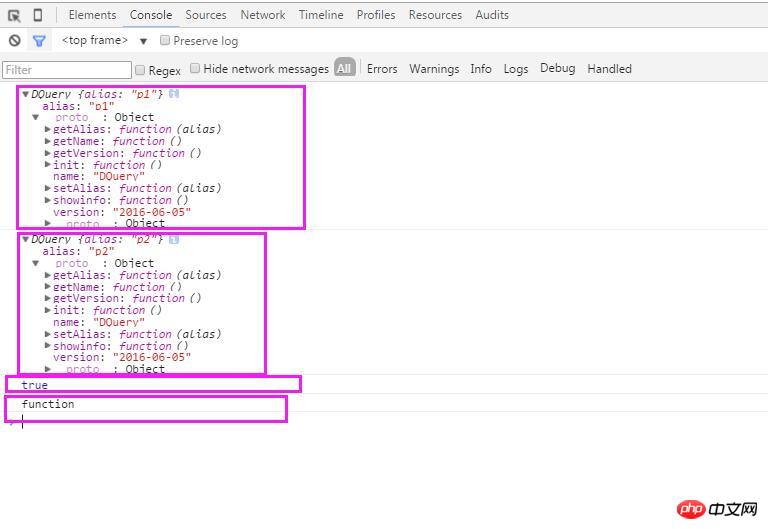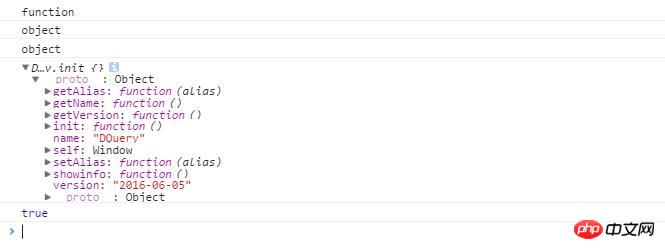이것은 다음과 같이 가장 간단한 캡슐화 방법입니다.
<script type="text/javascript">
/**
*自执行的匿名函数,可以实现链式调用
**/
(function(w){
var DQuery={
'name':'DQuery',
'version':'2016-06-05',
'getVersion':function(){
console.log(this.version);
return this;
},
getName:function(){
console.log(this.name);
return this;
},
showinfo:function(){
this.getVersion();
this.getName();
return this;
}
};
window.DQuery=$$=DQuery; //让外边可以调用
}(window)); </script> 장점, 간단함, 매우 쉬움 읽다.
단점: DQuery는 생성자가 아닌 객체입니다. DQuery가 출력되면 그 안에 포함된 모든 정보가 노출됩니다(아래 참조). 둘째, 다양한 상황에서 사용할 수 있도록 다양한 객체를 생성하도록 사용자 정의할 수 없습니다. 
이 버전은 누구나 가장 먼저 떠올리게 될 버전입니다.
(function(w){
var DQuery=function(){
this.alias=null;
}
DQuery.prototype ={ 'name':'DQuery', 'version':'2016-06-05', 'setAlias':function(alias){
this.alias=alias; return this;
}, 'getAlias':function(alias){
console.log(this.alias); return this;
}, 'getVersion':function(){
console.log(this.version); return this;
},
getName:function(){
console.log(this.name); return this;
},
showinfo:function(){
this.getVersion(); this.getName(); return this;
}
}
window.DQuery=$$=DQuery; //让外边可以调用
}(window));호출 코드는 다음과 같습니다
var p1= new DQuery();
p1.alias='p1'
var p2= new $$();
p2.alias='p2'
console.log(p1); console.log(p2);
console.log(p1.showinfo==p2.showinfo); console.log(typeof(DQuery));효과는 다음과 같습니다
장점: 출력에서 알 수 있듯이 우선 DQuery는 생성자이고, 이를 통해 해당 매개변수에 따라 다양한 객체를 생성할 수 있습니다. 둘째, DQuery 프로토타입에 정의된 변수와 함수는 모든 객체에 공통적이며 static과 동일합니다.
단점: 객체를 생성할 때마다 새로운 DQuery를 생성해야 하는 것이 조금 번거롭습니다. 둘째, 여전히 약간의 공개가 있습니다.
버전 1에서는 객체가 생성될 때마다 새로운 객체가 생성되어야 한다고 가장 먼저 생각하는 것은 객체를 다음과 같이 변경하는 것입니다.
var DQuery=function(){
this.alias=null; return new DQuery();
}이렇게 하면 코드 관점에서는 기존 문제는 해결됐지만 새로운 문제가 발생했습니다. 즉, DQuery에서 자신의 객체를 생성하는 것은 재귀 호출과 동일하므로 무한 루프 문제가 발생합니다. 
버전 1과 버전 2의 문제점을 고려하여 다음과 같이 개선할 수 있습니다.
(function(w){
var DQuery=function(alias){
this.alias=alias; return new DQuery.prototype.init();
}
DQuery.prototype ={ 'name':'DQuery', 'version':'2016-06-05', 'init':function(){
}, 'setAlias':function(alias){
this.alias=alias; return this;
}, 'getAlias':function(alias){
return this;
}, 'getVersion':function(){
return this.version;
},
getName:function(){
return this.name;
},
showinfo:function(){
return this.name+':'+this.version;
}
}
window.DQuery=$$=DQuery; //让外边可以调用
}(window));
console.log(typeof($$));//$$是一个构造函数
console.log(typeof($$()));//$$()返回一个对象
console.log(typeof(new $$()));//new $$()返回一个对象
var p1=$$('id1'); var p2=new $$('id2');장점: 버전 1 및 버전 2 버전 2에서는 기존 문제가 해결되었습니다.
단점: 클래스(생성자 내)의 속성과 메서드를 호출할 수 없습니다.
new로 생성된 객체의 경우 객체의 범위는 함수의 범위이며 프로토타입도 생성자의 프로토타입입니다(자세한 내용은 보충 내용) new DQuery.prototype.init();을 사용했기 때문에 반환된 객체의 프로토타입은 init 함수의 프로토타입과 동일합니다. 하지만 우리는 그것이 DQuery 함수의 프로토타입을 가리키기를 원합니다. 이 시점에서 두 가지 접근 방식이 있습니다.
옵션 1: init 메서드에서 DQuery 개체를 가리키는 이것을 반환하지만, 이 조건에서는 수행하기 어렵습니다. 왜냐하면 사용자가 다음을 통해 개체를 생성한다고 확신하기 때문입니다. new DQuery 또는 DQuery()를 직접 호출하여 객체를 생성합니다
옵션 2: init.prototype=DQuery.prototype을 설정할 수 있으므로 init 생성자를 사용하여 객체가 생성되더라도 객체의 프로토타입은 다음과 동일합니다. DQuery의 그것.
버전 3을 개선한 후 코드는 다음과 같습니다.
(function(w){
var DQuery=function(alias){
this.alias=alias;
return new DQuery.prototype.init();
}
DQuery.prototype ={
'self':this,
'name':'DQuery',
'version':'2016-06-05',
'init':function(){
}, 'setAlias':function(alias){
this.alias=alias; return this;
}, 'getAlias':function(alias){
return this;
}, 'getVersion':function(){
return this.version;
},
getName:function(){
return this.name;
},
showinfo:function(){
return this.name+':'+this.version;
}
}
DQuery.prototype.init.prototype=DQuery.prototype;
window.DQuery=$$=DQuery; //让外边可以调用
}(window));
console.log(typeof($$));//$$是一个构造函数
console.log(typeof($$()));//$$()返回一个对象
console.log(typeof(new $$()));//new $$()返回一个对象
var p1=new DQuery();
console.log(p1);
console.log(p1 instanceof DQuery); //true
우리의 요구 사항을 완벽하게 충족하고 위의 문제를 해결한 것을 확인할 수 있습니다.
처음에는 버전 4에는 문제가 없는 줄 알았는데, 결국 버전 4에도 여전히 작은 문제가 있다는 것을 알게 되었습니다. 즉, 반환된 개체가 속성에 액세스할 수 없다는 것입니다. DQuery 생성자에 의해 정의됩니다. 이 문제를 해결하려면 전화나 신청을 통해 해결할 수 있습니다. 물론 실제로는 필요하지 않습니다. 왜냐하면 init 메소드에서 일부 속성을 직접 정의할 수 있기 때문입니다. 왜 DQuery에서 속성을 정의하고 문제를 일으키나요?
****다음 버전은 계속 추가됩니다********** * **
대략적인 관계도는 다음과 같습니다
간략화된 코드는 다음과 같습니다
(function(w){
var DQuery=function(){
return new DQuery.prototype.init();
}
DQuery.prototype ={ //定义一些静态变量
'self':this, 'name':'DQuery', 'version':'2016-06-05', // 构造函数方法
'init':function(){
//定义一些变量属性
}, //定义一些方法
'setAlias':function(alias){
this.alias=alias; return this;
}
}
DQuery.prototype.init.prototype=DQuery.prototype;
window.DQuery=$$=DQuery; //让外边可以调用
}(window));먼저 새 개체의 프로세스를 요약해 보겠습니다. 예를 들어 Student 생성자를 사용하여 var s1=new Student() 개체를 만드는 과정은 다음과 같이 요약할 수 있습니다. 먼저 새 개체를 만들고 두 번째로 생성자의 범위를 새 개체에 할당합니다(따라서 이는 새 개체를 가리킵니다. Student.prototype은 객체 프로토타입에 할당됩니다. 그런 다음 객체를 s1에 할당합니다.
이 경우 기본적으로 새 개체 인스턴스가 반환됩니다.
1. 반환 값이 기본 데이터 유형인 경우에도 새 객체 인스턴스가 반환됩니다.
2. 반환값이 객체인 경우 반환된 객체는 지정된 객체값이 됩니다. 이 경우 이 값이 참조하는 개체는 삭제됩니다.
3. 함수를 반환하는 경우 new는 객체를 반환하지 않고 함수를 반환합니다.
//无返回值
function Student1(){
this.name='dqs';
} var p1=new Student1();
console.log(typeof(p1));//object
console.log('name' in p1 ); //true
console.log(p1 instanceof Student1 ); //true
//返回function
function Student2(){
this.name='dqs'; return function(){};
} var p2=new Student2();
console.log(typeof(p2));//function
console.log(p2 instanceof Student2 ); //false
//返回基本类型
//返回基本类型
function Student3(){
this.name='dqs'; return 'nihao';
} var p3=new Student3();
console.log(typeof(p3));//object
console.log('name' in p3 ); //true
console.log(p3 instanceof Student3 ); //true
//返回对象类型
function Student4(){
this.name='dqs'; return {'location':'hsd'};
} var p4=new Student4();
console.log(typeof(p4));//object
console.log('name' in p4 ); //false
console.log(p3 instanceof Student4 ); //false 위 내용은 JQuery 프레임워크 개발에 대한 내용입니다. 더 많은 관련 내용은 PHP 중국어 홈페이지(m.sbmmt.com)를 참고해주세요!